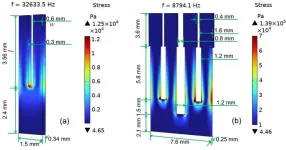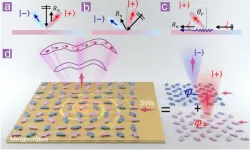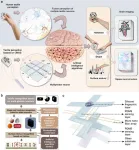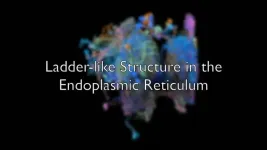(Press-News.org) Research Highlights:
Stroke survivors were more likely to have little or no disability after 90 days if a clot was removed from a large brain artery followed by the injection of the clot-dissolving medication tenecteplase directly into the artery near the blockage, compared to people receiving standard medical treatment after clot removal. In this trial, standard care was clot removal without clot-dissolving medication.
The added treatment may work by dissolving blood clots in the small vessels (microcirculation) near the major blockage, reducing the amount of brain tissue deprived of blood.
The ANGEL-TNK trial found that this approach was safe, with no added risk of brain bleeding in the first 48 hours or added risk of death from any cause within 90 days compared to receiving standard medical treatment.
Note: The study featured in this news release is a research abstract. Abstracts presented at the American Heart Association’s scientific meetings are not peer-reviewed, and the findings are considered preliminary until published as full manuscripts in a peer-reviewed scientific journal.
Embargoed until 11:27 a.m. PT/2:27 p.m. ET Friday, Feb. 7, 2025
LOS ANGELES, Feb. 7, 2025 — Removing a blood clot from a large brain artery, then injecting the clot-dissolving drug tenecteplase into the artery resulted in stroke survivors being more likely to have better function 90 days after their stroke than those receiving standard clot removal, according to preliminary late-breaking science presented today at the American Stroke Association’s International Stroke Conference 2025. The conference, in Los Angeles, Feb. 5-7, 2025, is a world premier meeting for researchers and clinicians dedicated to the science of stroke and brain health.
About 1 in 5 clot-caused (ischemic) strokes result from a clot obstructing a large artery (large vessel occlusions) in the brain. The standard of care in the U.S. per the American Heart Association/American Stroke Association 2019 Guidelines for the Early Management of Patients with Acute Ischemic Stroke and in China for this type of stroke is prompt removal of the clot to restore blood flow using minimally invasive endovascular treatment – a procedure that inserts a slim catheter (small tube) and/or a stent into an artery to retrieve the clot and restore blood flow, preventing further brain damage.
Without treatment, more than 80% of people with strokes caused by large vessel occlusions are disabled, and 20% die, based on prior studies. Even when clots are successfully removed, up to half of the people may die or be disabled three months later.
”Endovascular treatment can help restore blood flow in a blocked large blood vessel. However, it might not improve blood flow in the smaller vessels and microcirculation in the area. This clinical trial tests whether delivering tenecteplase directly into the affected artery after endovascular treatment can break up blood clots in the small vessels and improve blood flow, reducing the amount of brain tissue that lacks blood supply,” said Xiaochuan Huo, M.D., Ph.D., lead author of the study and director of the neurological disease center at Beijing Anzhen Hospital in China.
The current study, conducted at 19 centers in China, evaluated the safety and effectiveness of injecting tenecteplase directly into a large brain artery (intra-arterial injection) near where a clot was removed and restoring blood flow. All participants had large vessel occlusions and were treated between 4.5 hours and 24 hours after the last time they were observed to be well. According to the study protocols, 127 patients received tenecteplase and successfully underwent endovascular therapy, and 129 received standard medical care (in the full analysis population for the final results) after successful endovascular therapy. Disability was measured by a score of 0-1 on the modified Rankin Scale with ratings from 0 (no disability) to 6 (death).
The analysis found:
Stroke survivors were 44% more likely to have an excellent outcome (modified Rankin score 0-1) after 90 days if they received the tenecteplase injection and standard care after clot removal compared to those who received only standard care (40.5% vs. 26.4%).
Rates of brain bleeds in the two days after treatment were similar in those receiving tenecteplase (5.6%) and those receiving standard medical treatment (6.2%).
Rates of death from any cause within 90 days were similar in those receiving tenecteplase (21.4%) and those receiving standard medical treatment (21.7%).
“Intra-arterial tenecteplase after successful thrombectomy could improve the percentage of people with an excellent outcome. It could also improve the rate of large vessel occlusion stroke survivors who can return to society and live independently,” Huo said.
The researchers are following the participants to assess their one-year outcomes. Huo said their results may someday be used to change treatment guidelines for stroke survivors who have undergone successful clot removal. “We still need to directly analyze the individual data of participants in this and other trials – an individual meta-analysis – in order to release a high evidence-based recommendation,” Huo said.
The study did not include patients treated with intravenous clot-busting drugs or medications that reduce blood clotting, like heparin and anti-platelet drugs, during their endovascular procedures. This means that the benefits of intra-arterial tenecteplase shown in this study may not apply to people who received those treatments.
Study background, details and design:
ANGEL-TNK enrolled 255 participants (mean age of 70; 44.7% female) between February 2023 and March 2024 at 19 centers in 13 provinces of China.
All participants were adults who experienced a clot-caused (ischemic) stroke obstructing a large artery in the brain’s anterior circulation. All had blood flow successfully restored by having the clot removed via catheter or aspiration (breaks up and draws the clot through the tube) between 4.5 and 24 hours from the time they were last known to be well. No participants were disabled before their stroke. The main exclusion criterion was treatment with intravenous clot-busting medications (which, by Chinese guidelines, must be used within 4.5 hours after a person was last known to be well).
After successful restoration of blood flow, participants were randomized to receive either standard medical care or to have the clot-dissolving drug tenecteplase infused into the artery near the clot.
The primary assessment for the effectiveness of the additional treatment was the percentage of participants who had no symptoms or some symptoms but no disability 90 days later, as measured by a score of 0-1 on the modified Rankin Scale administered and scored by someone without knowledge of the treatment group.
The primary assessments for safety were brain bleeding within 48 hours of treatment or death from any cause within 90 days.
Study co-authors, funding and disclosures are available in the abstract.
Statements and conclusions of studies that are presented at the American Heart Association’s scientific meetings are solely those of the study authors and do not necessarily reflect the Association’s policy or position. The Association makes no representation or guarantee as to their accuracy or reliability. Abstracts presented at the Association’s scientific meetings are not peer-reviewed, rather, they are curated by independent review panels and are considered based on the potential to add to the diversity of scientific issues and views discussed at the meeting. The findings are considered preliminary until published as a full manuscript in a peer-reviewed scientific journal.
The Association receives funding primarily from individuals; foundations and corporations (including pharmaceutical, device manufacturers and other companies) also make donations and fund specific Association programs and events. The Association has strict policies to prevent these relationships from influencing the science content. Revenues from pharmaceutical and biotech companies, device manufacturers and health insurance providers and the Association’s overall financial information are available here.
Additional Resources:
Multimedia is available on the right column of release link.
Link to abstract LB38 and the ASA International Stroke Conference 2025 Online Program Planner
AHA news release: People of East Asian descent have more vessels reclog after endovascular treatment (July 2022)
AHA news release: Mechanical blood clot removal led to good recovery in half of stroke patients (Feb. 2022)
AHA news release: Newer clot-busting medication may someday increase time for stroke treatment (Feb. 2022)
For more news at ASA International Stroke Conference 2025, follow us on X @HeartNews #ISC25
About the American Stroke Association
The American Stroke Association is devoted to saving people from stroke — the No. 2 cause of death in the world and a leading cause of serious disability. We team with millions of volunteers to fund innovative research, fight for stronger public health policies and provide lifesaving tools and information to prevent and treat stroke. The Dallas-based association officially launched in 1998 as a division of the American Heart Association. To learn more or to get involved, call 1-888-4STROKE or visit stroke.org. Follow us on Facebook, X.
###
END
Removing large brain artery clot, chased with clot-buster shot may improve stroke outcomes
American Stroke Association International Stroke Conference – Late-Breaking Science Presentation - LB 38
2025-02-07
ELSE PRESS RELEASES FROM THIS DATE:
A highly sensitive laser gas sensor based on a four-prong quartz tuning fork
2025-02-07
A new publication from Opto-Electronic Advances; DOI 10.29026/oea.2025.240275, discusses A highly sensitive laser gas sensor based on a four-prong quartz tuning fork.
Trace gases, though have a volume fraction much less than 1% of the atmosphere, significantly impact various sectors. Despite their low concentration, typically between 10-12 to 10-6, gases like nitrogen oxides (NOx), sulfur dioxide (SO2), and greenhouse gases contribute to atmospheric pollution, a pressing global issue exacerbated by industrialization and urbanization. Moreover, detecting trace gases is crucial for industrial ...
Generation of Terahertz complex vector light fields on a metasurface driven by surface waves
2025-02-07
A new publication from Opto-Electronic Sciences; DOI 10.29026/oes.2025.240024, discusses generation of terahertz complex vector light fields on a metasurface driven by surface waves.
With the rapid development of information and communication technologies, especially in the context of 5G, 6G networks, artificial intelligence, and the Internet of Things, the development of on-chip optical control devices with high bandwidth, high speed, low power consumption, and miniaturization ...
Clot-busting meds may be effective up to 24 hours after initial stroke symptoms
2025-02-07
Research Highlights:
In a randomized clinical trial in China, giving the clot-busting medication alteplase up to 24 hours after stroke symptoms first appeared increased the odds of better recovery by 50% compared to those who received standard antiplatelet treatment.
The results might extend the time window for patient treatment worldwide, particularly in regions that lack access to advanced medical procedures.
Note: The study featured in this news release is a research abstract. Abstracts presented at the American Heart ...
Texas Tech Lab plays key role in potential new pathway to fight viruses
2025-02-07
Five years removed from the COVID-19 outbreak, scientists around the world are still studying its effects and, more importantly, ways those effects can be mitigated in the future. An international team of researchers may have just found a critical clue in the quest, and a laboratory at Texas Tech University played a key role.
The Ray Laboratory, led by Department of Biological Sciences Professor and Associate Chair David Ray, as part of a study on bat genomes published by the scientific journal Nature, helped identify the components of a genome in a specific species of bats that have shown more genetic adaptations in their immune systems than other animals.
The study revealed that a gene ...
Multi-photon bionic skin realizes high-precision haptic visualization for reconstructive perception
2025-02-07
A new publication from Opto-Electronic Advances; DOI 10.29026/oea.2025.240152, discusses how multi-photon bionic skin realizes high-precision haptic visualization for reconstructive perception.
Human palm skin contains more than 20,000 tactile vesicles, depending on the tactile vesicles in the skin depth, activation threshold, trigger mode and other tactile signal pickup differences, as well as cross-synergistic mechanism between them, so that the skin can obtain different types of tactile signals. And then through the brain nerve center on the tactile signal “calculation” ...
Mitochondria may hold the key to curing diabetes
2025-02-07
Mitochondria are essential for generating energy that fuels cells and helps them function.
Mitochondrial defects, however, are associated with the development of diseases such as type 2 diabetes. Patients who suffer from this disorder are unable to produce enough insulin or use the insulin produced by their pancreas to keep their blood sugar at normal levels.
Several studies have shown that insulin-producing pancreatic β-cells of patients with diabetes have abnormal mitochondria and are unable to generate energy. Yet, these studies were unable to explain why the cells behaved this way.
In a study published in Science, ...
Researchers explore ketogenic diet’s effects on bipolar disorder among teenagers, young adults
2025-02-07
UCLA Health is set to begin a multi-site pilot study to explore whether a ketogenic diet, when combined with mood stabilizing medications, helps stabilize mood symptoms in teenagers and young adults who have bipolar disorder.
Preliminary research on the effects of a ketogenic diet in people with bipolar disorder have shown improvements in mood and in overall executive function, but these open trials have been limited to adults. This will be the first study conducted on the diet’s effects among youth and young adults with bipolar disorder.
Set ...
From muscle to memory: new research uses clues from the body to understand signaling in the brain
2025-02-07
Our biceps and our brain cells may have more in common than previously thought.
New research led by the Lippincott-Schwartz Lab shows that a network of subcellular structures similar to those responsible for propagating molecular signals that make muscles contract are also responsible for transmitting signals in the brain that may facilitate learning and memory.
“Einstein said that when he uses his brain, it is like he is using a muscle, and in that respect, there is some parallel here,” says Janelia Senior Group Leader Jennifer Lippincott-Schwartz. “The same machinery is operating in both cases ...
New study uncovers key differences in allosteric regulation of cAMP receptor proteins in bacteria
2025-02-07
Washington, D.C. – A new study, “Identifying Allosteric Hotspots in Mycobacterium tuberculosis cAMP Receptor Protein” published in Biochemistry, provides key insights into how bacterial cAMP receptor proteins (CRPs) respond differently to the ubiquitous signaling molecule, cyclic AMP (cAMP). By comparing the allosteric regulation of Escherichia coli CRP (CRPEcoli) and Mycobacterium tuberculosis CRP (CRPMTB), researchers challenge the assumption that structural similarity predicts functional behavior in allosteric proteins.
This ...
Co-located cell types help drive aggressive brain tumors
2025-02-07
A type of aggressive, treatment-resistant brain tumor has a distinct population of immune cells that support its growth, according to new research led by investigators at the Johns Hopkins Kimmel Cancer Center Bloomberg~Kimmel Institute for Cancer Immunotherapy and the Johns Hopkins University School of Medicine.
Searching for subtypes of immune cells seen only in the most serious, grade 4 brain tumors, called glioblastomas, and using a recently developed technology called spatial genomics, ...
LAST 30 PRESS RELEASES:
New fossil study illuminates on the evolutionary success of frogs
Patient-specific human liver model to understand disease mechanisms
Confused by the doctor's questionnaire? U of A study suggests it's common
How do brains stay stable, and when might a dose of flexibility be helpful?
mRNA revitalizes aging immune systems—the liver as a fountain of youth
Rural-urban differences in the prevalence of chronic pain among adult cancer survivors
Food insecurity, burnout, and social isolation among resident and fellow physicians
How do spinal cord injuries heal?
Detailed cell map unlocks secrets of how reproductive organs form
Large language models unleash AI’s potential for autonomous and explainable materials discovery
Gut bacteria have evolved rapidly to digest starches in ultra-processed foods
New risk score helps predict pancreatic cancer recurrence
New evidence challenges understanding of Parkinson’s disease
A new study reveals how embryos and the uterus “talk” during implantation
Cedars-Sinai reports heart attacks, general illness spiked after LA fires
PolyU develops ultra-stable, mucus-inspired hydrogel to boost gastrointestinal wound healing
Flour choice shapes sourdough microbial communities
Can a retinal implant reverse macular degeneration?
Feeding fungi plant remnants produces tasty protein to fortify vegan, vegetarian diets
New tech reduces false positives from breast ultrasounds
Drone-mounted lab monitors fertilizer runoff in real time
Short, light-intensity exercise boosts executive function and elevates mood in children
Jeonbuk National University researchers reveal new interface engineering strategy for efficient and stable back-contact solar cells
Tyrosinase drives hydroquinone-induced exogenous ochronosis: not HGD inhibition
UMass Amherst chemists develop unique tool for studying RNA
Disappointment alters brain chemistry and behavior
A built-in odometer: new study reveals how the brain measures distance
Stress-related brain signals drive risk of cardiovascular disease in people with depression and anxiety
New details on role of fat transport molecules in Alzheimer’s onset
Study illuminates how an antiviral defense mechanism may lead to Alzheimer’s disease
[Press-News.org] Removing large brain artery clot, chased with clot-buster shot may improve stroke outcomesAmerican Stroke Association International Stroke Conference – Late-Breaking Science Presentation - LB 38



